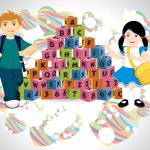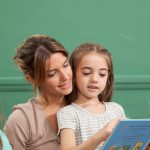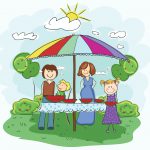So we know that vocabulary is very important for learning to read and especially for understanding what you read. Children learn a lot of words! Some estimates say that school-aged children learn around 3000 new words a year while children aged 12-17 are exposed to around 10,0000 new words from school text books alone. Multilingual children don’t necessarily transfer vocabulary labels from one language to another because they tend to acquire the words in the specific context in which they hear them We use our languages for different purposes (telling a story, telling a joke, playing with toys, playing with peers, telling news at school) with different people (parents, cousins, grandparents, neighbours, teachers) and in different places (home, crèche, school, playground, church) and naturally this affects our vocabulary. That’s why their vocabularies are naturally uneven in each language. For multilingual children, it’s the total number of words across all of their languages that matters when testing their vocabulary. When children go to school in a different language than their home language- like Polish at home and English at school, their home language needs intensive support to keep on developing. And building the home language helps them learn the school language more easily. This post is about teaching words to children from towards the end of their third year. If you want tips for building first words, you can read here.
What does the research have to say about teaching vocabulary? (When I say teaching here, I don’t mean at school in a formal way. I mean what you can do in your everyday life in natural fun ways to support your child’s language development).
Dialogic Book Reading supports children’s vocabulary development. It takes a little getting used to but you can read all about how to do it here and here. You can start doing it from as young as 22 months of age. And it’s fun! In the second link, you’ll find two handouts you can print out and stick on the fridge to keep you on track.
What else works? Practicing vocabulary in a variety of rich, meaningful contexts helps multilingual children expand their vocabulary and remember the new words they’ve learned. Repetition and review are important. So see if you can find ways to weave words from the story you read at night into your conversation next day and make an explicit link back to the book. My little girl is reading Heidi at the moment and there are plenty of new words in it. She called out from her bed the other night; “How do you pronounce g-e-n-t-i-a-n?” I told her and then we had a chat about Gentian Hill which is near our house. Then a day or so later, we looked them up on Google Images to refresh and review. You get the idea- lots of chats about the words and examples of where you can use them. You can talk about the word and how it’s said and used in all of their languages. Maybe there isn’t an equivalent word and that’s worth talking about too.
You can give examples of words with similar meanings too (synonyms). So if the word is astonishment, you can talk about words that have a similar meaning such as surprise, amazement, wonder and so on. And you can do this for all of the languages your child needs. Another way to work on synonyms in a fun way is to grab a piece of paper and put a word in the middle and see how many synonyms you can generate using all of your languages. And watch out for naturally occurring opportunities to draw attention to words. We were reading Astrid The Unstoppable at bed time and noticed how the verb say was used a lot for characters’ speech. There were very few other verbs to do with talking. So the next day, we just got a piece of paper and wrote down all the words we could think of that were about talking from whispered through to screeched. The more dramatic the better of course! When playing this kind of game you can also weave in strategies for generating words like searching your mind alphabetically to see what words crop up. Or you can categorise by features like volume for the words to do with talking.
So let’s say your child is reading in Polish and they come across a word they don’t know. You tell them and you have the chat about it. Then you can tell them what it is in English (if that’s your community language) and continue your conversation about the word using your home language. You can also use what’s called vocabulary bridging where you use your home language to support vocabulary development in the school language. You can read about it here. For older children who have started school (you can do this at a younger age too if is your child is keen), you can add in that the word is a noun, or verb, or adjective, or preposition. And then explain why. When reading together, let’s say you come across an unfamiliar word- last night we had salamander in Harry Potter & The Chamber of Secrets. Immediately, my little girl was asking “What’s that?” I wasn’t entirely sure- “Some kind of lizard” I thought but not totally sure. We read on and of course, the next line expanded on the meaning. So I’ve been trying (with variable success…) to encourage her to keep reading or listening as the meaning is often made clear when you read on further. (Technical term for this: contextual abstraction). You can also help your child use a dictionary to find out the range of meanings for the words and what kind of word it is. (Technical term for this: direct instruction).And again, you can do it for all your languages for the one word.
For school aged children (and younger depending) you can also look at the parts that go together to make up the word and how you can make words up from different parts. If we go back to Heidi and astonishment, we can talk about the sentence Heidi stood and looked at it, speechless with astonishment. (The stool that her grandfather rustled up for her) In that sentence, it’s a noun. We can take off the –ment at the end and turn it into a verb to astonish or an adjective Heidi was astonished. We can thinking of other words with –ment at the end and see if they work the same way. (Technical term for this: morphological analysis). Words where the –ment works are words like bewilderment, amazement, encouragement, advertisement but not figment or cement. Then you can have conversations about how these word parts work in your different languages which is great for building metalinguistic awareness and strengthening linguistic connections. It could also be things like how the adjective comes before (red house) or after the noun (teach dearg in Irish) or that the verb is at the start of the sentence like in Irish. This word awareness is an important skill for children to learn so that they can become independent word learners. For older children knowing a word will include knowing how to spell it and how to say it.
Other ways to expand word knowledge are:
- Coming up with expressions that use the word in a non-literal way like it’s raining cats and dogs, green fingers
- Does the word have a function? Like if the word is salamander, what can you do with a salamander? Look it up on line, see it at the zoo, avoid it! Or what can a salamander do? Walk, blink, swim etc
- Where would you see or find the item if it’s a concrete noun? Or for something more abstract like entertainment you can talk about the different forms it takes: books, movies, concerts
- What category does it belong to? A salamander is an amphibian (yes I Googled it!!) It’s an animal – so the wide category first and then get narrower.
- Does it have an opposite? Like unruffled, unmoved for astonished.
- Can you describe it using the senses? Does it have a sound associated with it? How does it smell? Feel? Look?
- What is the first sound in it?
- What’s the last sound in it?
- How many sounds in total?
- First and last letters? How many letters in total?
- What words rhyme with it?
- Put it in a sentence.
One more thing- you can weave many of these strategies into one game so that it feels more natural and fun. We did this recently at home while looking for something to do. I took out the Scrabble board and we played with new rules that we agreed together:
- All the tiles out at the same time
- Words in any language were permitted
- Slang was allowed
- We didn’t bother with scores
If you want to see what we made, go to the Talk Nua Facebook page here.
Can you spot the Irish swear word? It wasn’t me!! (Okay I added the –er but it is morphology, right?!!)
If you liked this post, please pass it on to your friends.
Let’s get talking!
MP
What I read so you don’t have to
Joffe, V. (2011) Vocabulary Enrichment Programme UK: Speechmark
Restrepo, M., Morgan, GP., & Thompson, M. (2013) The efficacy of a vocabulary intervention for dual-language learners with language impairment. Journal of Speech Language & Hearing Research 56: 748-765.










